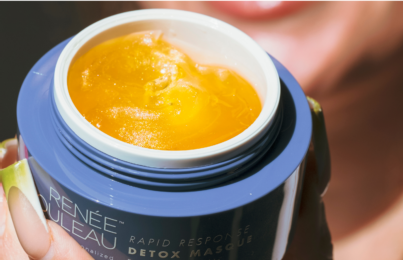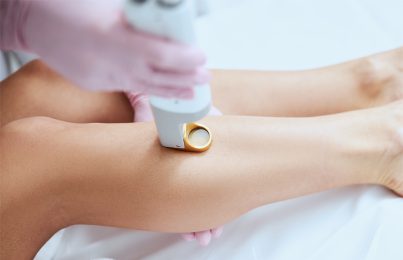Updated 07/11/23. Anyone who’s ever waxed their bikini line knows that ingrown hairs come with the territory. These often painful bumps have a swollen, blemish-like appearance. To make matters worse, they can leave behind a red or purple mark, similar to a post-breakout scar, long after they’ve healed.
Even though they may seem inevitable (especially during the summer months), there are ways to prevent them from ever appearing in the first place! In this post, I’ll share my process for preventing post-wax ingrown hairs. I’ll also discuss how to get rid of them quickly if they’ve already appeared. Let’s go!
What Is an Ingrown Hair?
An ingrown hair occurs when hair curls back into the skin or grows sideways. Essentially, it gets stuck without a direct path out, which results in a sore, red, and inflamed bump. They often occur after undergoing a hair removal method like shaving or waxing. As the hair grows back, it can become trapped. And, as I said before, even when an ingrown hair is resolved, it can still leave a dark mark behind. This pigmentation is stubborn; it can linger for months without fading.
Who Is Prone to Ingrown Hairs?
Anyone can get ingrown hairs, and they’re quite common. However, you’re more likely to get them if you have thick, dark, and/or curly hair. Studies show that African-American individuals are more likely to experience ingrown hairs after shaving. This is due to the hair structure and the position of the hair in the follicle. While these studies are only concerned with ingrown hair formation after shaving, it may also be true for waxing.
How to Prevent Ingrown Hairs
Up until a couple of years ago, when I finally decided to pursue laser hair removal, I was a monthly waxer for over 25 years. I would get my bikini area done, as well as my lower legs, so I know ingrown hairs all too well. They can be difficult to get rid of once they appear, so prevention is key. Luckily, I found a prevention strategy that worked well for me, and I hope it will work well for you, too!
P.S. In the picture above, I’m paddleboarding on Ladybird Lake, while at home in Austin, Texas! I’m constantly spending time outside in the summer, and I love being on the water, but that doesn’t mean that my skin isn’t protected. To make sure I’m keeping my skin safe from damaging UV rays, I wear sun-protective clothing, seek shade when possible, and apply (and reapply) a generous amount of sunscreen every day.
Keep reading to see my process for preventing ingrown hairs after getting a bikini wax.
Days 1 – 6
Your skin will be fairly sensitive within the first few days post-wax. During this time, it’s important to be gentle with it. I would always apply a lightweight body lotion to the area. This helps keep skin cells hydrated. Aside from that, though, I wouldn’t do anything else to avoid aggravating the skin.
With that being said, some people struggle with post-wax redness. If you’re one of them, and you want to calm your skin down, there are two things you can do. The first is to ice the affected area. The second is to apply a cooling, gel-based mask.
Days 7 – 14
At this point, the hairs you’ve waxed are growing back. They’re not ready to come to the surface of the skin, but they’re getting closer. This is when you should start exfoliating. Use a gentle leave-on exfoliating acid to allow the hairs to come out easily once they’re ready. The idea is that exfoliation removes dead skin cells from the surface, which ensures that nothing is blocking the hair from coming out or forcing it to grow in a different direction.
During this stage, I would apply a thin layer of the DERMAdoctor KP Duty Lotion every other day after showering. It contains a blend of powerful acids to exfoliate the skin and address texture and tone.
Days 15 – 30
About two weeks after your bikini wax, you may feel your skin start to get prickly. This is when the hairs are beginning to come out. This is also when your skin may start to feel itchy. At this time, you should start using a physical exfoliant to loosen the hair from the surrounding skin. This will keep it from getting stuck before it grows out of the follicle.
I recommend using a physical exfoliant every other day. There are a lot of options. You can use a body scrub (check out this DIY version), a washcloth, a loofah, a dry body brush, or this Back and Body Buffing Towel. No matter which option you choose, don’t scrub too hard. And, once again, be sure to follow up with a body lotion. This will hydrate the area and help soften hairs, so they’re less likely to poke at the surrounding skin.
Don’t use a physical and chemical exfoliant on the same day. Instead, alternate between the two every other day (so, if you use a physical exfoliant today, use an exfoliating acid serum tomorrow). During this time, you may be exfoliating every day, so it’s important to monitor your skin. Back off if it starts to look or feel sensitive.
At some point during this 15 to 30-day period, many people go back to get another bikini wax and start this routine over again.
What to Do (and Not Do) If You Develop an Ingrown Hair
No matter how dedicated you are to prevention, chances are that you’ll see one or two ingrown hairs eventually take hold. If that’s the case, there are a few things you should know. The first is that you can’t (and shouldn’t) squeeze or “pop” an ingrown hair the way you would a blemish. There’s a lot of hardened skin that forms over ingrown hairs, so you’d have to squeeze really hard to get them out. This could cause damage, not to mention pigmentation that could linger long after the ingrown hair is resolved.
How to Get Rid of an Existing Ingrown Hair
- Sanitize the area around the hair and make sure your hands are clean.
- Use a lancet (you can get these at a drugstore or pharmacy. They’re the same kind used by diabetics for finger pricks.) Use it to carefully pierce the skin to create an opening for the hair to come out.
- You may have to gently move the tip of the lancet around to find the hair and physically lift it out. Depending on where the hair is in its life cycle, it could still be connected to the follicle. This means that, once you get the end of the hair out, you may have to gently tweeze it to fully remove it.
- After removing the hair, apply an antibiotic ointment to the area.
- Wait at least three days before doing any physical or chemical exfoliation.
You can also use a non-drying spot treatment like the Anti Bump Solution to address ingrown hairs. Make sure the area around the ingrown hair is clean and free from any other products (like lotion, for example). Then, dab a small amount of the Anti Bump Solution onto the affected area. You can do this every single day until the bump diminishes in appearance.
Anti Bump Solution is also a great addition to any men’s skincare routine. If you find yourself struggling from bumps and ingrown hairs after shaving your face, add a little of this for a quick fix!
Of course, ingrown hairs will eventually resolve on their own without intervention. That said, the longer an inflamed bump lingers, the more stubborn the subsequent pigmentation will be. So, by (carefully and responsibly!) taking matters into your own hands, you can minimize dark marks.
If an ingrown hair isn’t coming out easily, slow your roll and wait until it’s loosened. You don’t want to end up doing more harm than good. If the bump persists for an extended period of time or becomes enlarged and extremely painful, consult a doctor.
The Bottom Line
If you follow my prevention plan and modify it as needed, your ingrown hairs should be a thing of the past. If you continue to struggle with ingrown hairs, you might consider laser hair removal. The downside, of course, is that it can get pricey and it isn’t always ideal for every skin type. Those with darker skin tones should be especially careful when it comes to lasers since there is a higher risk of triggering pigmentation. Talk to an experienced technician to learn if laser hair removal is a good option for you.
Next, learn how to get your armpits smooth and summer-ready!
Celebrity Esthetician & Skincare Expert
As an esthetician trained in cosmetic chemistry, Renée Rouleau has spent 30 years researching skin, educating her audience, and building an award-winning line of products. Her hands-on experience as an esthetician and trusted skin care expert has created a real-world solution — products that are formulated for nine different types of skin so your face will get exactly what it needs to look and feel its best. Trusted by celebrities, editors, bloggers, and skincare obsessives around the globe, her vast real-world knowledge and constant research are why Marie Claire calls her “the most passionate skin practitioner we know.”




Comments:
i have the purple marks they leave behind . im so embarrassed that i wear shorts instead of regular bottoms with my swimsuit.. is there ANY way to get rid of them?
Posted By: brooke alexander |
Hi Brooke,
All of the exfoliating strategies used to prevent ingrown hairs will also help to fade the purple marks. But above and beyond those techniques, our Post Breakout Fading Gel can be used on the bikini area to expedite the fading process. Check it out here https://www.reneerouleau.com/PostBreakOutFadingGel.aspx
Posted By: Renée Rouleau |